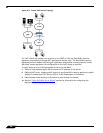
VoIP
532
SonicOS Enhanced 4.0 Administrator Guide
Figure 47:3 Point-to-Point VoIP Service Topology
This deployment does not require a VoIP server. The Public IP address of the SonicWALL
security appliance is used as the main VoIP number for hosts on the network. This requires a
static Public IP address or the use of a Dynamic DNS service to make the public address
available to callers from the WAN. Incoming call requests are routed through the SonicWALL
security appliance using NAT, DHCP Server, and network access rules.
To make multiple devices behind the SonicWALL security appliance accessible from the public
side, configure one-to-one NAT. If many-to-one NAT is configured, only one SIP and one NAT
device will be accessible from the public side. See “
“Network > NAT Policies” section on
page 245
” for more information on NAT.
See the “
Using the Public Server Wizard” section for information on configuring this deployment.
Deployment Scenario 2: Public VoIP Service
The Public VoIP Service deployment uses a VoIP service provider, which maintains the VoIP
server (either a SIP Proxy Server or H.323 Gatekeeper). The SonicWALL security appliance
public IP address provides the connection from the SIP Proxy Server or H.323 Gatekeeper
operated by the VoIP service provider. The following figure shows a public VoIP service
topology


















